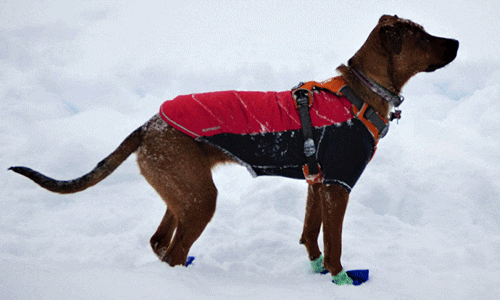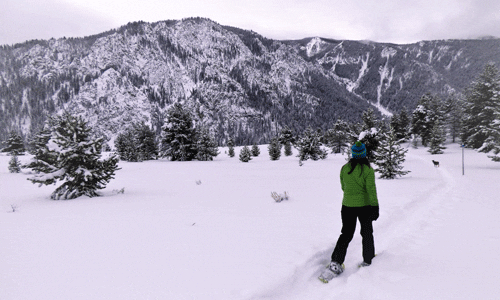By Amy Freed
There are many things that come to mind when you hear the word “winter” – chillier temperatures, warm drinks, and cozying up next to a fireplace. Winter can be very fierce at times, and yet gentle with fluffy, cotton-like snowflakes that you can catch on your tongue.
Winter is all about making the most out of each day. One of the best ways to make the most out of your winter days is to take a snowshoe walk on nearby trails in West Yellowstone, Montana.
Snowshoeing is a great activity for the whole family, or just to enjoy some bonding time in nature with your canine companion. When you go snowshoeing, you can take time to really enjoy your surroundings and go at your own pace. One of the most scenic local trails is Refuge Point. It’s an easy to moderate 2.3 mile loop along the Madison River.
Refuge Point History
Refuge Point gets its name from the 1959 earthquake. There was a landslide at the Madison River Canyon that caused people to go up to the ridge, which is the trail’s namesake. From here, they were rescued by US Forest Service Smokejumpers.
When snowshoeing along the trail, you can read more about the 1959 earthquake and stop by the Visitor Center, which is conveniently located right down the road from the Refuge Point trailhead. (The visitor center is open daily May-Sept.)
Trail Location
From West Yellowstone, head north on US Highway 191 for 10 miles. Turn west on US HWY 287 and keep going for 13 more miles. The trailhead is clearly marked as Refuge Point.
What to Expect
You can expect pure beauty! The trees are covered with snow, mountains surround you in every direction, and you can even spot the Madison River. This river is notoriously known for its wonderful fly fishing around June and July, but also provides spectacular views in the winter months.

Be prepared to climb over some snow piles at the start of the trail. This un-groomed trail is very well marked with blue diamond symbols displayed along the route. There are gentle rolling hills for the first half, which makes it easy for beginner-level snowshoers. If you go off of the snow-packed trail, expect to come upon very deep snow that you could fall through up to your hip (or if you are a dog completely over your head like the dog pictured, Seeley.)
The second half of the trail is a bit hillier and has a larger climb at the end to get back to the parking lot, so be sure to save up some energy to climb the last hill. You should expect to take about two hours to complete the trail.
Gear
One of the most important things to remember is to dress like it is 10 degrees warmer outside than what it actually is. This will help you from getting overheated and sweating, which can be dangerous in colder temperatures. Here’s what you will need for gear:
- Snow pants
- Light puffy jacket
- Non-cotton base layers
You want to wear something that will be wicking,
- Light mittens
- Hat
- Waterproof snow boots
- Snowshoes and poles
This trail does not require very aggressive snowshoes, but proper fit is very important. For this particular trail you would want Hiking/Recreational snowshoes with tubular framing, but flat stock frames would work as well. When measuring place the snowshoe heel on the floor and stand it against your calf. The toe portion should hit your knee or right below it.
Freeheel and Wheel in West Yellowstone can rent out the proper gear for your snowshoe hike and help supply any winter gear you may have forgotten at home.
If you have a furry friend accompanying you on your hike you must pay attention to the breed of your dog and do some research to make sure your pet stays safe and warm. The Seeley is a short-haired mixed breed and weighs about 50 pounds. This is what Seeley wore on her snowshoeing adventure:
- Ruffwear Powder Hybrid jacket
- Ruffwear Front Range Harness
- Musher Booties with vet wrap
She does not have much fur on her pads so to keep them from cracking and getting ice in them she wears booties with vet wrap around the velcro up to her carpal pad to keep it from slipping off when she would dive into deep snow.
Doggy Den Pet Supply in West Yellowstone has all of this gear to make sure your dog is well taken care of for winter activities.
When you are going on your adventure be sure to take a small backpack packed with plenty of food and water for humans and dogs alike, and any emergency first aid supplies to be prepared for an emergency. Another item to bring in the beginning and towards the end of the winter months is bear spray just in case some stubborn bears decide to be awake when there is snow.
With wonderful views of mountains, the river and snow-covered trees along with plenty of new history facts to learn, Refuge Point is one of the most beautiful snowshoe hikes around the West Yellowstone area. Winter is about making the most out of the short days, so go out and enjoy the snow with your human and four-legged friends.
